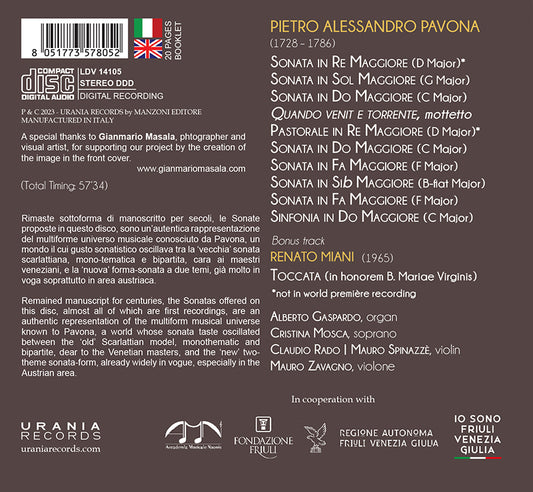Collection: Pietro Alessandro Pavona
Pietro Alessandro Pavona (1728 - 1786)
He was born in Palma on 15 June 1728 to Francesco di Pietro, from Verona, serving in the Venetian garrison, and Giovanna Casoti. Nothing is known about his youth and training; it is said that he was a pupil of Bartolomeo Cordans, but there is no documentary evidence to confirm this, except a copy of a motet by Cordans made by the young Fr. Ventenne received the clerical tonsure in Udine and, in 1749, it became part of the chapter school of S. Maria Assunta in Cividale del Friuli.
In 1751, on the death of the titular organist, Giuseppe Zanchetti, the P. was unanimously elected to succeed him. His first autograph dated to that year. In the cathedral in Cividale he dedicated himself to teaching, to the choice, composition and direction of music in the main liturgical festivities. He received commissions from the confraternities of the Battuti and the Santissimo Crocifisso, from the secular house of the spinsters of Udine between 1778 and 1786; and invitations to conduct musical performances, from the Basilica of the Saint in Padua in 1761, to the cathedral of Udine for the solemn entry of the new archbishop G. G. Gradenigo in 1762, in Grado in 1772 together with the organist Luigi De Grassi, in Tolmezzo in 1773.
In 1777 he dedicated a collection of sacred songs for soprano and orchestra to the abbess of the monastery of S. Maria di Aquileia, Maria Redigonda of the lords of Maniago. Per Palma wrote an introit for the beatification of Saint Lawrence of Brindisi in 1784. His musical practice did not end in the duties imposed on him by the role, but he crossed into the secular realm. On 25 January 1757, in fact, Patriarch Daniele Delfino threatened to suspend the Cividale mansionaries if they had persevered in participating «in the figure of musicians» at carnival time to the theatrical performances involving the nobility of the city and of which, Perhaps, remains trace in arias and symphonies of unknown provenance.
On 17 October 1786, at the age of fifty-eight, he died at Manzano in the Foscolini house. Most of his known works are preserved handwritten in the place where he served for at least thirty-six years, or at the parish of St. Maria Assunta of Cividale del Friuli, in the Chapter Music Archive, in thirty-seven volumes, 21 envelopes and other units scattered in the various funds for a total of 284 units, in the set of unit songs and anthologies.

-
PAVONA: FREMENS UNDA FURIBONDA
Vendor:Urania RecordsRegular price €18,00 EURRegular priceUnit price / per€0,00 EURSale price €18,00 EUR


